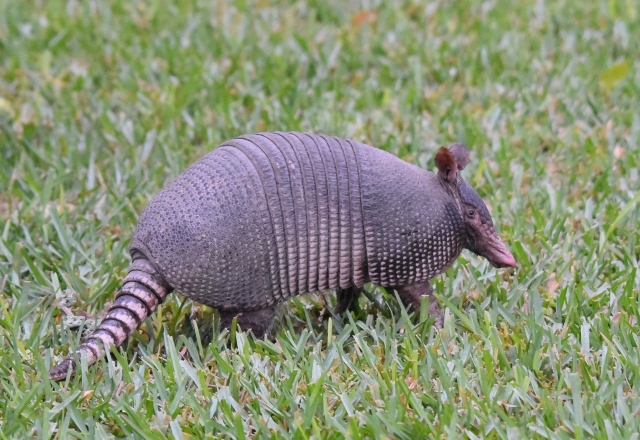By Anita Westervelt, Texas Master Naturalist

The nine-banded armadillo is the only species of armadillo in the United States, although 20 species exist throughout Central and South America.
Nine-banded armadillos live throughout Texas except in the Panhandle and the Trans-Pecos. The species is found as far north as southeast Nebraska and Illinois, and east through Tennessee, Georgia and South Carolina.
Generally seen trundling along, snuffling at the ground with a slight sweeping motion of its head, the nine-banded armadillo can approach speeds to 30 miles an hour when fleeing a predator. There’s not much for them to fear in the Valley except coyotes and vehicular traffic; further north, and in Louisiana, they are prey to mountain lions, black bears and alligators.
The name armadillo means “little armored one” in Spanish. Their shell is made up of bone plates, known as scutes, which are covered in overlapping scales and connected by flexible, leathery skin. It is the only mammal that has bone plates in its skin. The critter has additional protection on the top of its head, upper limbs and tail. The underside has only soft skin and fur.
These unique-looking critters are about two and a half feet long from nose to tail tip and weigh about 12 pounds. Contrary to rumor, only the Brazilian three-banded armadillo can roll itself into a ball to foil a predator. The nine-banded armadillos have to rely on dense shrubs in which to hide, or scurry to one of several burrows it has dug out around its territory.
Nine-banded armadillos are nocturnal in the summer and diurnal during winter. They are very sensitive to temperature because they have poor insulation under their armor. In winter, they tend to be active during the warmest part of the day, in summer, at night, when it is cooler.
Armadillos are mainly insectivores. They have poor eyesight, but excellent hearing and a very keen sense of smell. They eat beetles, larvae, worms, termites, cockroaches, fire ants, scorpions, white grubs, grasshoppers, ants, maggots and snails as well as a small amount of fruit, seeds, fungi and other plant matter. They also eat spiders, snakes and frogs. Their diet is regional- and habitat-dependent.
Ever helpful in ridding a yard of many pests, especially grass-killing grubs, they unfortunately root out their fare by digging with their large, sharp, thick, strong claws. They leave a yard full of annoying holes for the property owner to find.
Armadillos generally take up residency near water, which doesn’t limit their territory. The nine-banded species can hold its breath for up to six minutes and cross a stream or resaca by walking across the riverbed. Alternately, they can suck air into their intestines which enables them to swim. They have a strong doggy-paddle stroke.
Armadillos have a history as a food source for humans. The nine-banded armadillo was nicknamed “poor man’s pork” and “Hoover hog” by people who blamed President Hoover for the Great Depression, according to armadillo-online.org.
On the other hand, it is true that armadillos are the only animals that can contract leprosy from humans and pass it on to other humans. Scientists believe that in order to contract leprosy from an armadillo, one must frequently handle the animals, and/or consume armadillo meat.
Sources: “Critters of Texas Pocket Guide,” Adventure Publications, Inc. Online sources, National Wildlife Federation, havahart.com and a-z-animals.com.